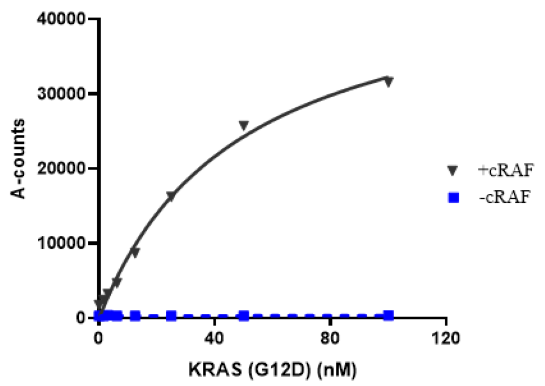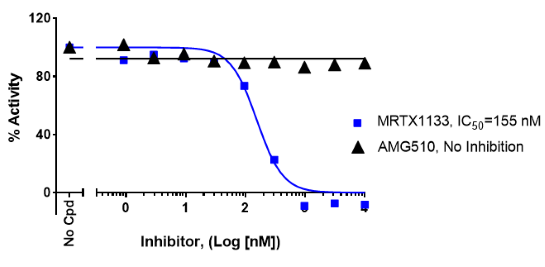KRAS(G12D) Coupled Nucleotide Exchange Assay Kit
The KRAS(G12D) Coupled Nucleotide Exchange Assay Kit is designed for screening and profiling of KRAS(G12D) antagonists/inhibitors by monitoring the binding of an effector protein such as the Ras binding domain of Raf1, (RBD-cRaf) to KRAS(G12D). The KRAS(G12D) Coupled Nucleotide Exchange Assay Kit comes in a convenient 384-well format, with enough purified recombinant GDP-loaded KRAS(G12D) Isoform A, GTP, exchange factor SOS1 (amino acids 564-1049), effector protein RBD-cRAF (amino acids 50-140), assay buffer and additives for 400 reactions. With this kit, a few simple steps on a microtiter plate are required for nucleotide exchange detection. First, a sample containing GDP-loaded KRAS(G12D) is incubated with SOS1 and GTP for the nucleotide exchange. Next, RBD-cRAF is added and incubated for the effector-RAS binding. Then, acceptor and donor beads are added and incubated for detection followed by reading the Alpha-counts.
SOS1 (son of sevenless) is a guanine nucleotide exchange factor that facilitates the exchange of GDP for GTP. GDP-loaded KRAS(G12D) is in an inactive state and does not interact with the Ras-binding domain (RBD) of cRAF. SOS1 assists in the release of GDP from KRAS(G12D) so that GTP can occupy the nucleotide binding pocket. This results in a conformational change in KRAS(G12D) that permits its binding to RBD-cRAF. The KRAS(G12D) Coupled Nucleotide Exchange Assay Kit utilizes GST-tagged RBD-cRAF and His-tagged KRAS (G12D) to assay binding of KRAS(G12D) to RBD-cRAF in the Alpha assay. Glutathione acceptor and Ni chelate donor beads are brought into proximal range by the binding of KRAS(G12D) and RBD-cRAF, enabling the energy transfer from the donor to acceptor beads after laser excitation.

Figure 1: Illustration of the assay principle.
| Name | Ordering Information |
| AlphaLISA® Glutathione acceptor beads, 5 mg/ml | PerkinElmer #AL109C |
| AlphaScreen® Nickel Chelate donor beads, 5 mg/ml | PerkinElmer #AS101D |
| Optiplate -384 | PerkinElmer #6007290 |
| AlphaScreen® microplate reader | |
| Adjustable micropipettor and sterile tips |
| Catalog # | Name | Amount | Storage |
| 101312 | KRAS(G12D), Isoform A, His-Tag, GDP-Loaded * | 5 µg | -80°C |
| 101573 | SOS1, FLAG-Tag* | 50 µg | -80°C |
| 100519 | RBD-cRAF, GST-Tag* | 5 µg | -80°C |
| 79861-2 | 10 mM GTP | 0.5 ml | -20°C |
| RBD-RAS Binding Buffer (Incomplete) | 2 x 3 ml | -20°C | |
| 0.5 M DTT | 2 x 200 µl | -20°C | |
| 79311 | 3x Immuno Buffer 1 | 4 ml | -20°C |
*The concentration of the protein is lot-specific and will be indicated on the tube.
It is well established that RAS mutations are responsible for more than 30% of human cancers. KRAS(G12D) is the most common mutation (33%) among KRAS mutant tumors. The G12D mutation favors the activated (GTP-bound) state of KRAS, amplifying signaling pathways that lead to oncogenesis. Recent studies have led to the discovery of a small molecule called MRTX1133 (Mirati) that locks KRAS conformation in the GDP-bound inactive state, thereby blocking KRAS(G12D)-mediated signaling pathway. Compounds that affect the nucleotide exchange (GDP to GTP) reaction could lead to a novel approach leading to the inhibition of tumor cell growth in KRAS(G12D) driven tumors.
Wang, X., et al., 2022 J Med Chem 65: 3123-33.
Hillig, R.C., et al., 2019 PNAS USA 116 (7): 2551-2560



